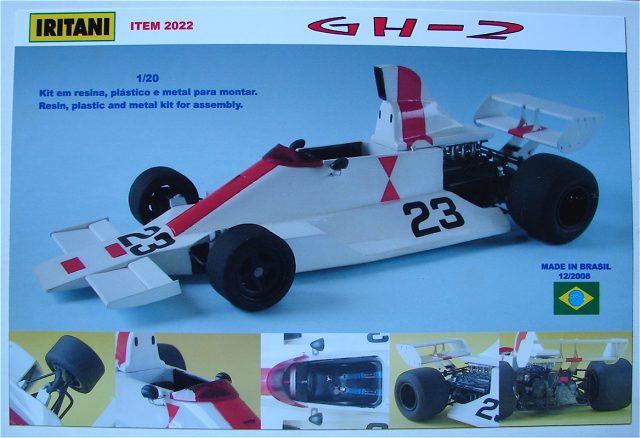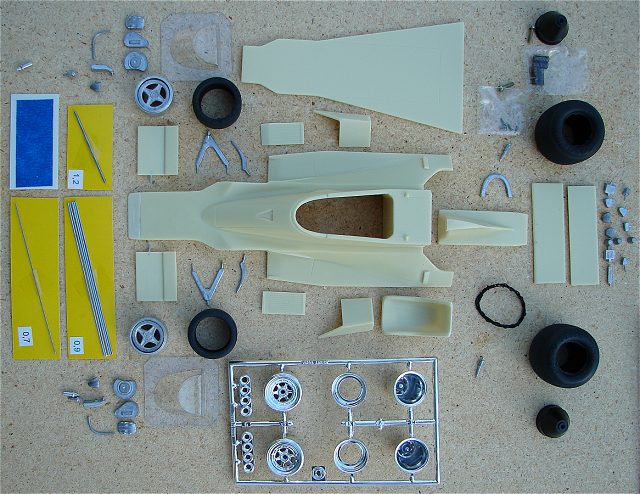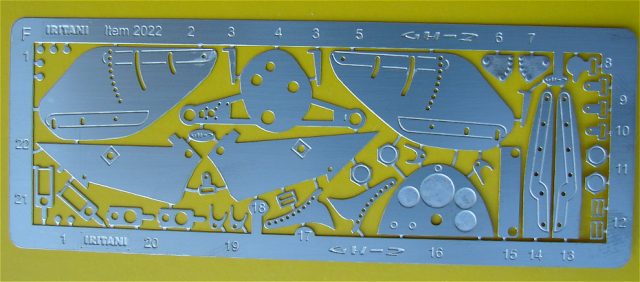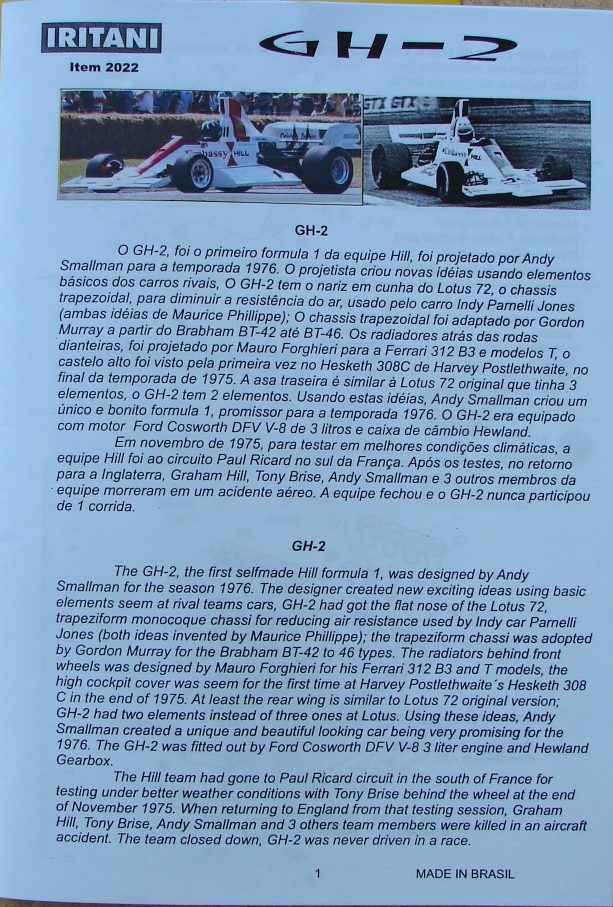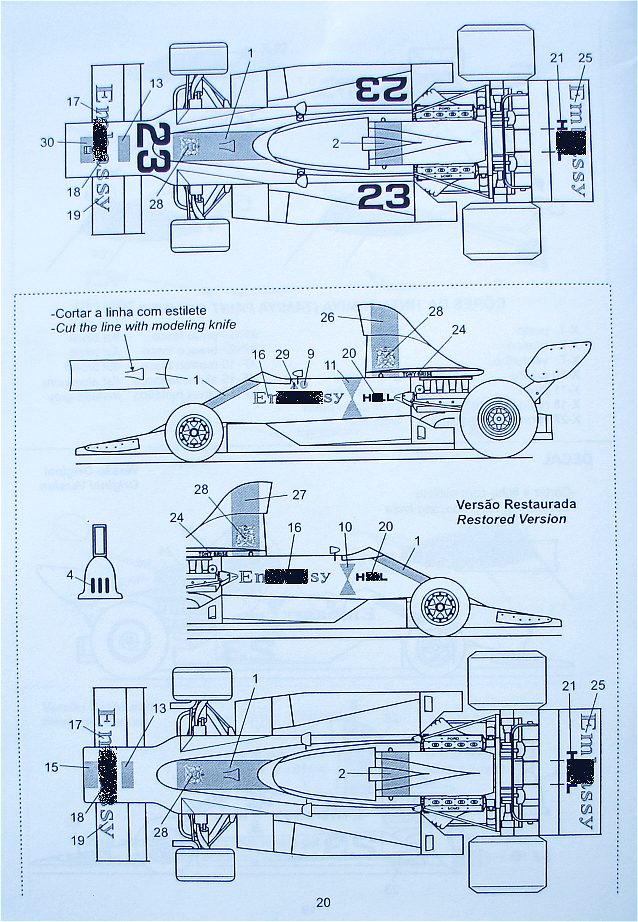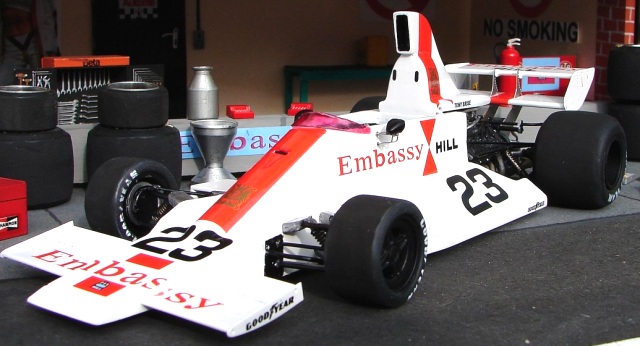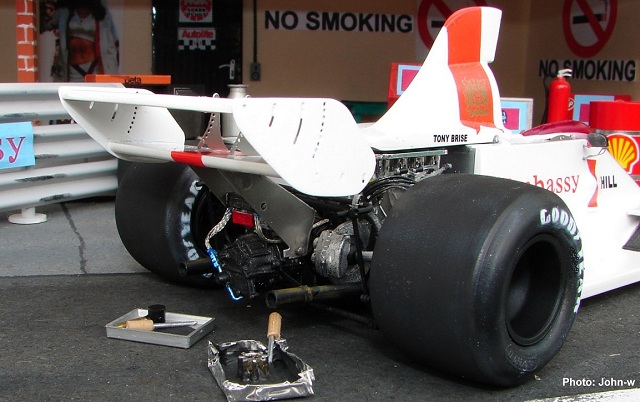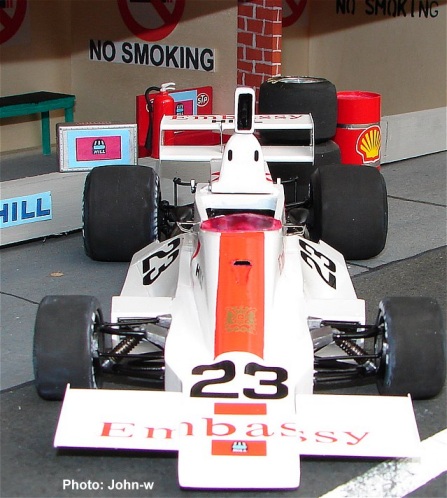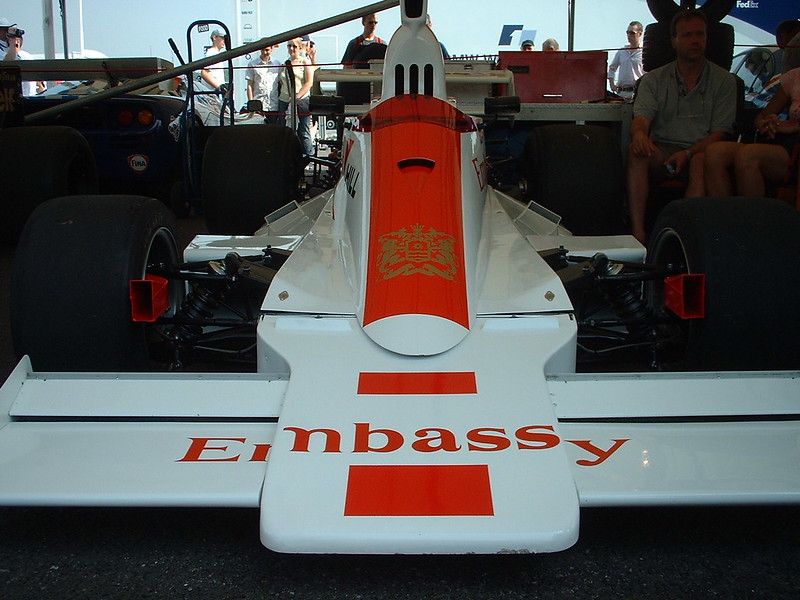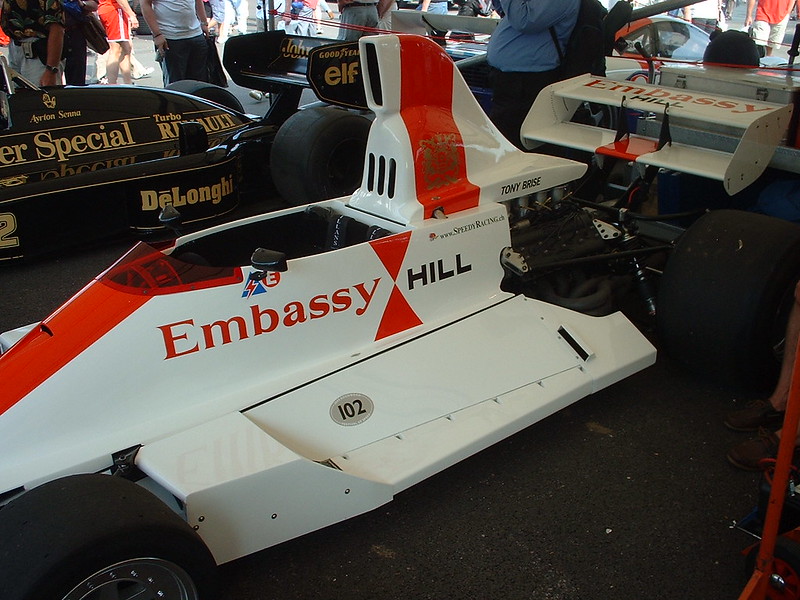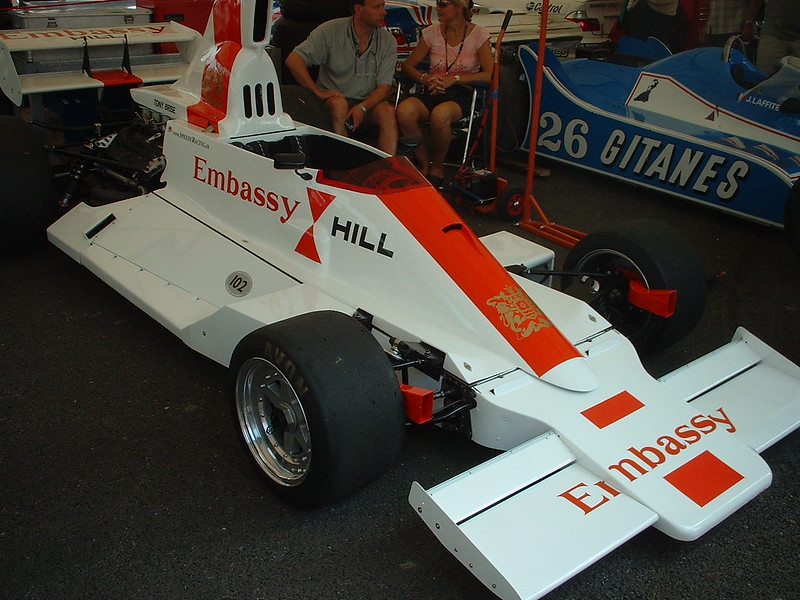Posted 11 November 2008 - 14:05
Peter,
I can only agree with your observations - I would also essentially look at a chassis of this nature as being two closed-section beams tied together at their ends (and ocassionally along the way as well, for instance at the front roll hoop) and then being loaded in differential bending. The fabricated 'horns' carrying the front spring/dampers and upper wishbones are outrigged pretty far and thus provide a lot of leverage to twist the GH2 side beams, and they also sit some distance aft of the chassis front bulkhead, so that may have been a weak area due to the many load introduction off-sets. In this day and age we would probably exploit some scheme of remote location of the spring/damper units in order to locate load introduction points closer to where we find room for our main structure. Still, not having done the calcs, the GH2 structure may have been 'stiff enough', even though it certainly doesn't look ideal. I don't suspect the front roll-hoop structure really provides much in the way of a connection between the side beams - it looks a lot better on the 008 - actually the only thing that looks slightly 'iffy' to me on the 008 is the upper attachment to the engine, simply due to the relatively small diameter of the tubes that react the longitudinal loads there, but again not having done the calcs, they may well be 'stiff enough'.
The way the front hoop stays on the GH2 cross half-way between the apex of the hoop and at their feet on the chassis seems to me to add an uncessary node in the system - I would have configured the stays as an inverted vee with its apex at the top of the hoop. A lot of seventies cars have hoop stays configured in the way used on the GH2; the only advantage I can see off-hand is that it does provide some degree of in-plane lateral triangulation without having to locate the stays right at the top of the hoop, where the node may risk being worn away if the car scrapes inverted along the tarmac. Either that or I may have overlooked some other advantage to crossing the stays, rather than letting them meet at top of the hoop?
I'll have to sift through my old Autosports to see if I can find a picture of what the GH2 structure looks like where the engine is attached before I can comment on that area.
Remi,
If you're reading this thread: Do you have any photos of the 'naked' GH2 chassis other than those on Gurneyflap?
So, just to elaborate a bit on Dave's and Peter's observations for those with a just a passing structural interest: Moving the beams further apart increases differential bending (aka 'torsional') stiffness, simply by increasing the moment arm length available for bending moment resistance, but as Peter pointed out, this requires sufficient stiffness of the transverse bulkeads and their connections to the side beam longerons to work as intended (and as always load introduction and distribution is always a challenge). When there is no more structural overall width available, or no restriction of height, inceasing individual beam section, particularly in height, is more efficient, as the section modulus increases to the third power of the linear dimension normal to the axis around which we bend (strength to the second power), all else being equal (shear/compression buckling stability due to thin, large panels eventually comes into play).
Chassis such as the GH2, the Tyrrell 008, Hesketh 308C/Williams FW05 and in USAC Bob Riley's mid-seventies Coyotes and Wildcats all had shallow but broad and (relatively) wide-spaced side beams, and some were race winners (008 and Riley's cars). As Peter pointed out, the devil is in the details - how to make the beams work together and how major loads are fed into them - a thin sheet floor pan didn't do much in this respect, so bulkheads and behind-driver fuel tank box had to do it. A sucessful (measured in race wins) flat-wide chassis that comes to mind is the Lola T330/332 F5000/single seat Can-Am.
Quite a few sports-prototype chassis over the years have also had the flat-wide architecture, some sucesfully, others not.
I suppose that one of the things that helped the flat-wide chassis of the pre-ground effect seventies work reasonably well was the use of, by modern standards, very softly sprung suspension so that the deflection of the chassis remained minor relative to that of suspension springs, and that the wishbone loads remained pretty much in the horizontal plane, where each side beam was quite stiff due to great width, and where the floor structure helped, too.
On paper the 308C/FW05 may have worked by merit of individually 'stiff enough' side beams, but, as Peter pointed out, the 308C later had a transversal bridge added just behind the front rocker mounts. Adding weight high-up in a chassis is never done without a good reason...
As the wheel rates greatly increased with the introduction of ground effect aerodynamics, structural inadeqaucies became readily apparent, as Dave points out, not least on the Lotus T79. Getting stiffness into an aerodynamically-driven small (narrow) chassis cross section naturally led to increasing the side beam height right up to the edge of the cockpit opening, but, with hindsight, it was a surprisingly long time in coming, and structurally the Lotus T79 certainly seems to me a retrograde step relative to the T78. I would guess (disregarding the tubular front suspension supports) that both the T77 and the T78 were stiffer in torsion than the T79 (and I also speculate that poor Ronnie Peterson would have been killed instantly in a T79, but there may not have been a fire - seeing how badly the T78 honeycomb sandwich tub front was damaged by the impact on the Armco and its supports, I fear the single-skinned T79 nose would have fared even worse). Carbon fibre materials technology was then the next stage in obtaining stiffness by using material with vastly higher modulus of elasticity (and higher strength, too) from a small chassis cross-section, and yet pioneering Barnard stayed loyal to the shallow, open, exposed cockpit area for aerodynamic flexibility (which didn't appear to be used much anyway) for a surprisingly long time.
At the end of the day racing car design (indeed, all engineering!) is a matter of finding the best compromise for the intended purpose, so structurally it was (and still is, as nothing is infinitely stiff) a question of 'stiff enough', which allowed the flat tub/tall non-structural "conning tower" architecture to prosper for a little while. I suppose its advantages were seen as aerodynamic (small cross section not masked by the wheels, clean flow to rear wing) and a low centre of gravity.
From the safety aspect, the driver did seem to be very exposed when sat 'on' rather than 'in' the tub, but tall, narrow structural cockpit sides back then typically would have meant thin aluminium sheet and little else, which wouldn't have provided much resistance against side impact and would have increased the risk of the driver getting trapped in the chassis, which was the last thing you wanted back in the days when fire was the big killer. Once we got the fuel out of harm's way (as in the T79 architecture) the risk of fire was greatly reduced, and then any lateral structure could be better used for sacrificial impact protection rather than for housing fuel. Still, aluminium honeycomb panels were already in use back then (1976 McLaren M26 used a lot of it), so again with the benefit of hindsight, it is perhaps rather surprising that it wasn't used for structural cockpit fairings sooner, but the need simply wasn't there from a structural point of view when the fuel mostly lived in the side box beams. The 1979 Fittipaldi F6 had tall aluminium honeycomb side panels (and the Wolf WR9 also to a certain extent) and all the fuel behind the driver, but these cars were not succesful (for other reasons). Had they been, I suspect all subsequent cars would have had tall side structural side panels from 1980, but that, of course, is pure speculation. BTW, IIRC Chapman went backwards structurally with the T79 because he found honeycomb sandwich panels too difficult to stress, fabricate, assemble and repair, so it may have been a simple case of Team Lotus' seemingly persistent lack of time AND money...He and Lotus did learn from that mistake relatively quickly, though, (with help from Peter Wright) so, not surprisingly, Lotus had the first deep-sided carbon composite tub ready at the same time as Barnard's pioneering MP4/1...
Come to think of it, I can't OTTOMH remember a driver being killed or seriously injured in a shallow chassis car due to lack of lateral protection above hip height, but there may have been some - perhaps in Lola T330/T332s as there were so many of those in front line action?
I've always been a bit surprised that so few used a triangular section for the box beam longerons - easy to build and with its truss-like cross section it could rely less on closely spaced bulkheads for torsional stiffness relative to a rectangular or other polygon shape, which would have been handy in the days when the fuel bags typically resided there. I also just happen to like the shape visually...
Peter,
Aren't Murray's triangular beam chassis just neat? I wouldn't be surprised if they are impressively stiff, even by modern standards. The Ken Sears/John Surtess TS19/20 was also quite neat and visually pleasing, and probably also very stiff for its generation. Another thing I find very neat is the way that Murray obtained a degree of progressive pullrod-operated springing simply by locating the pivot of the bottom 'tappet' high on the chassis, rather than using a massively complicated 'spider' on the upper wishbone, as on Lotus T72/76, Parnelli VPJ1, Ensign MNo75-77 and Amon AF1 - Murrays method was also used on the Surtess but in a somewhat less elegant manner (although rather I do like Surtees' wide-based lower rear wishbone and upper parallel links).
Anyway, on the subject of suspension members, with wishbones being 'wear items' one wants them to be simple items - on our Formula Fords we let the pullrod pick up directly on the uprights (also at the front), so our wishbones are just tubes and laser-cut lug plates, all of them non-handed (oops - sorry about the shamless plug and thread detour...)
Peter,
it's just great to have somone of your awesome present-day design stature show such deep affection and interest for our sport's history - keep it up!
